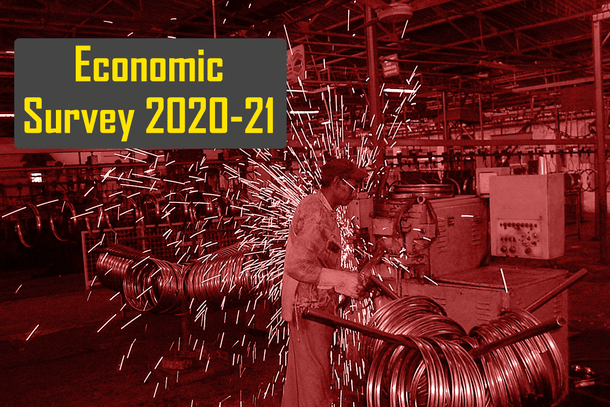Infrastructure
Economic Survey Gives Neat And Complete Summary Of Atmanirbhar Bharat Abhiyan’s Boost To Industry And Infrastructure: Read Here
Swarajya Staff
Jan 29, 2021, 06:20 PM | Updated 06:20 PM IST
Save & read from anywhere!
Bookmark stories for easy access on any device or the Swarajya app.


The Economic Survey for 2020-21 was tabled in Parliament today by Union Finance Minister, Nirmala Sitharaman.
Volume 2, chapter 8 of the document provides a complete summary of those measures of the central government's Atmanirbhar Bharat Abhiyan that helped the industrial and infrastructure sectors.
The Atmanirbhar Bharat programme was the name given to the central government's stated aims and policies of making India a self-reliant country.
At a time when the national economy was reeling under the havoc wreaked by the Covid-19 pandemic and the subsequent lockdown, the Atmanirbhar Bharat Abhiyan was arguably the most important remedial measure taken by the government.
The announcements under the Atmanirbhar programme were made in three tranches and the Economic Survey lays out the measures announced in each for helping and boosting the industrial and infrastructure sectors specifically.
Atmanirbhar Bharat 1.0
The first announcement provided support and relief to the MSME sector, the power sector, the real estate sector, and contained announcements on reforms regarding public sector enterprises.
MSME sector
There were nine announcements made for MSME especially.
1. Rs 3 lakh crore collateral-free automatic loans for businesses, including MSMEs: The Emergency Credit Line Guarantee Scheme (ECLGS) was formulated to provide MSMEs with an additional funding of up to Rs 3 lakh crore in the form of a fully guaranteed emergency credit line.
2. A further provision of Rs 20,000 crore of subordinate debt was made for MSMEs which were NPAs or were stressed.
3. The government also announced the setting up of a fund of funds with a corpus of Rs 10,000 crore that will provide equity funding support for the MSMEs. The targeted equity infusion here though was even higher at Rs 50,000 crore.
4. A new definition of MSMEs was given because many enterprises were previously wary of graduating out of the benefits of being a medium, small or micro enterprise.
5. For procurement by government, only domestic enterprises were allowed to apply for tenders upto value of Rs 200 crore.
6. All dues owed to MSMEs by government to be paid within 45 days; besides other measures.
7. Priority to income tax refunds worth Rs 5,204 crore issued.
8. Prompt payees of Mudra loans offered interest subvention. Total relief worth Rs 1,500 crore.
9. More ease of doing business reforms.
Power Sector
Rs 90,000 crore liquidity injection for DISCOMs was announced.
Real Estate Sector
The government announced extension of RERA deadlines to de-stress real estate developers and ensure completion of projects so that homebuyers are able to get delivery of their booked houses within new timelines.
Public Sector Enterprise Policy
In the first announcement under the Atmanirbhar Abhiyan, the government also said that it would 'announce a new coherent policy — where all sectors are open to the private sector while public sector enterprises (PSEs) will play an important role in defined areas'.
The government added that even in strategic sectors, at least one enterprise will remain in the public sector but private sector will also be allowed.
In other sectors, PSEs will be privatised (timing to be based on feasibility etc.)
Atmanirbhar Bharat 2.0
In the second announcement, the government provided Rs 25,000 crore as additional capital expenditure to the Ministry of Road Transport and to the Ministry of Defence.
Atmanirbhar Bharat 3.0
The most important announcement in the third tranche was that of production-linked incentives worth Rs 1.46 lakh crore that were provided to 10 sectors to boost domestic manufacturing.
Apart from this, Rs 18,000 crore of additional outlay for PM Awaas Yojana (PMAY) –Urban, was announced.
Additionally, Rs 6000 crore equity infusion for the National Investment and Infrastructure Fund (NIIF) Debt Platform was announced and another Rs 10,200 crore of outlay was provided ‘towards capital and industrial expenditure for domestic defence equipment, industrial incentives, industrial infrastructure, and green energy’.
You can read the full chapter on industry and infrastructure here.




